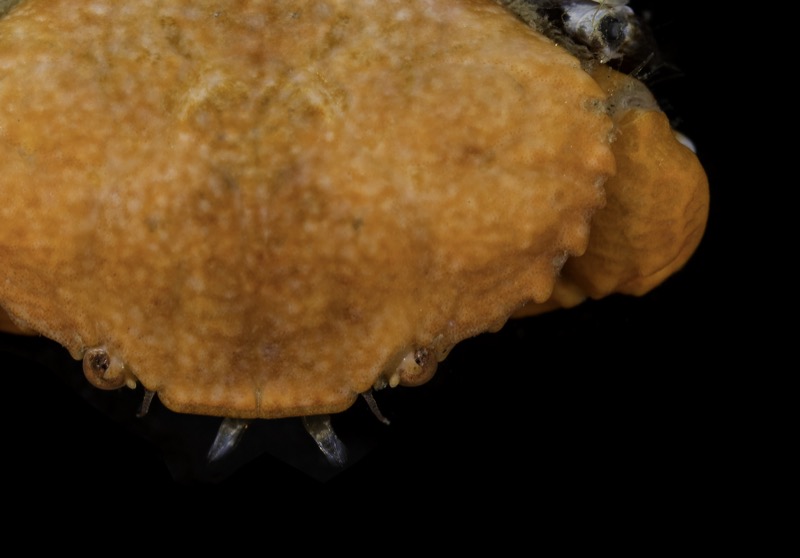
The intertidal of Cabrillo National Monument is home to over 35 species of crustaceans. Of those, twelve are brachyurans, or true crabs. The blackclaw crestleg crab (Lophopanopeus bellus bellus) (Rathbun, 1900), sometimes called the blackclaw pebble crab, is an inhabitant of the lower intertidal and shallow subtidal waters of the Eastern Pacific. It occurs from the Aleutian Islands of Alaska down to the central coast of Baja California, and shares part of its range with a very similar and closely related subspecies called Lophopanopeus bellus diegensis.
The brilliant young crab pictured here is just over one centimeter across. But even full grown, the blackclaw is a relatively small species of crab. Males reach only 34mm and females 24mm, measured across the carapace. The bright orange color of this individual is almost unreal and threw me off at first glance, but the species can be quite variable in hue. Carapace colors range from rusty orange to brown, grey, green, purple, or sometimes calico patterned.

Blackclaws are omnivorous. Although they are known to graze on several types of algae, the blunt morphology of their claws designates them as “shell-breaking” crabs. Their strong and stout chelipeds give them the ability to predate on hard-shelled prey items like mussels, barnacles, and even other crabs. They are also thought to be significant predators of young abalone. For their size, they are not only formidable but also quite prolific. Females can release as many as 36,000 eggs per brood, and they spawn two times each year! The first brood is produced and released during the months of December through April, and the second between May and August.
The blackleg crestclaw crab may be new to my seashore naturalist eyes, but this species has been around for quite while. In fact, fossils of Lophopanopeus date back to the Pleistocene, over 2.5 million years ago. So, the next time you are out in the lower intertidal zone take a closer look in the crevasses and among the tangled holdfasts of algae. You just might behold one of these fascinating and ancient crustaceans.
Sources:
Abbott, Donald Putnam, Haderlie, E.C. Intertidal Invertebrates of California
Stanford University Press, 1980. 609-611
Behrens Yamada, S., Boulding, E.G., Claw morphology, prey size selection and foraging efficiency in generalist and specialist shell-breaking crabs. Journal of Experimental Marine Biology and Ecology 220, 1998. 191 – 211
Campos, Ernesto, Rosa de Campos, A. Range extensions of decapod crustaceans from Bahia Tortugas and vicinity, Baja California Sur, Mexico. California Fish and Game, vol. 75, no. 3. 1989. 174-177
Griffiths, Allison M. ,Gosselin, L. Ontogenetic shift in susceptibility to predators in juvenile northern abalone, Haliotis kamtschatkana Journal of Experimental Marine Biology and Ecology, Volume 360, Issue 2, 2008. 85–93
Menzies, Robert James. A revision of the brachyuran genus Lophopanopeus. Vol. 4. University of Southern California Press. 1948.
